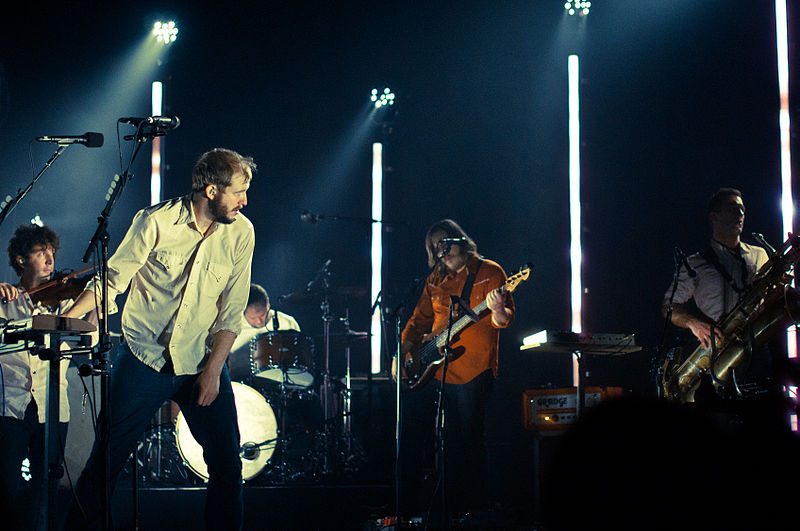Swinging wide the door to The Local Store in Eau Claire, Wisc., it was hard not to feel like a rock star. Not because I am one (What’s the opposite of a rock star?), but because, due to the store’s back-to-back scheduling of events, I was opening for Bon Iver.
All right, that’s not entirely true. Probably not even a little true. What I mean to say is that a song I’d written—the only song I’ve ever written—was being debuted alongside a few other first-time songwriters’ attempts directly before a pre-release listening party for Bon Iver’s latest album, i,i.
My elevation to opening-act status was not made at Bon Iver front man Justin Vernon’s request, but rather, what I imagine was his horror. Nothing like a tune from B.J. “What’s a Flugelhorn?” Hollars to get the party started.
I’d have never written the song in the first place were it not for a solicitation from a local middle school chorus teacher, who gathered together a few writers and promised to set our words to music. Initially, I’d demurred (“I have too much respect for music,” I’d said), but she insisted. And so, we writers momentarily set aside our novels and our essays and tried to determine what a song was supposed to sound like. I had some vague notion, of course, but given my own defection from music following a two-week stint of fifth-grade trumpet, I was feeling vulnerable in a new medium.
And that vulnerability felt glorious.
What a rare gift to be given permission to fail. Or rather, to spin it more optimistically, to “succeed to a lesser extent.” While writing the song, I’d set the bar so low that even I could limp over it. The product hardly mattered. What mattered was the process; specifically, my attempt at utilizing the fundamental skills I employed in other literary genres and applying them to lyrics.
The resulting song—thanks to the talented chorus teacher—wasn’t half-bad. In fact, I’d be lying if I said I didn’t feel a fleeting hint of pride. Not for what I’d done, but for what we’d done together. We took a risk and the risk paid off.
In the hour or so leading up to Bon Iver’s listening party, 40 of us took our seats in The Local Store for a sing-along from our selection of newly-composed songs. As the program neared its end, I turned to spot a roomful of fans anxiously awaiting the Bon Iver listening party, fans that hadn’t intended to hear a B.J. Hollars’s original but may have heard one anyway. And lived to tell of it.
The idea that an amateur like me can share a “stage” alongside a Grammy-Award winning band like Bon Iver (even if only by way of a listening party) speaks to one of art’s greatest gifts: its potential for inclusion. From finger painting to a gallery exhibition at The Museum of Modern Art, it’s possible to carve out space for us all. And sometimes, if the scheduling works in your favor, even the same space.
That night, while leaving The Local Store, I watched the Bon Iver fans descend upon the room we’d just vacated. Within minutes, they’d be encircled around a record player in that darkened room, heads bowed as they did that rarest of 21st-century things: sat silently together. The scene was repeated at 59 other locations worldwide, thousands gathering for a first listen of Bon Iver’s latest effort.
Within hours, reviews for i.i. began pouring in. Most were positive, with the exception of a scathing two out of five-star review from The Guardian’s Ben Beaumont-Thomas, who called the album a “misfire,” claiming Vernon’s melodies were “uninspired” and accusing the musician of, on a few occasions, “squat[ting] in his comfort zone.” As for Vernon’s lyrics, Beaumont-Thomas remarked that the songs “feature a few lucid pleas for understanding…amid acid-addled sermonizing.”
Thank goodness he wasn’t there for my opening act, I thought.
For me, Beaumont-Thomas’s final line left the deepest cut, the reviewer arguing that if Vernon is “trying to build Bon Iver into a mini-utopia of shared values,” then “he needs to be a stronger leader.”
To critique i.i on its artistic merit is one thing, but to critique Vernon’s well-known effort to create and support a robust community of artists and musicians—a community, I’ll add, in which even a guy like me can occasionally sneak in the back door—seems a rather low blow. If Beaumont-Thomas means—as I think he does—that Vernon’s so-called “burgeoning hippy paradise” has corrupted his musical vision, then I suppose we can agree to disagree. But for my part, I prefer to think of Vernon’s community of artists as something larger than any album, more vital than any song, and more empowering and inspiring than any review.
While it’s true that my songwriting “career” began and ended with a single song, that song wouldn’t have been written at all were it not for the chorus teacher’s willingness to populate her own “mini-utopia” with imperfect “songwriters” like me. In doing so, she reminded me that vulnerability can serve as rocket fuel for the muse. It doesn’t guarantee greatness, but it guarantees growth.
As all artists know, it’s easy to create the safe thing, but it’s courageous to take the risk. Which is why the art that I admire most invites failure at least as often as success. Leave it to the critics to tell us whether or not we pulled it off. “While they are deciding,” as Andy Warhol famously said, “we’ll make even more art.”
Image credit: Wikimedia Commons/Daniel J. Ordahl.









